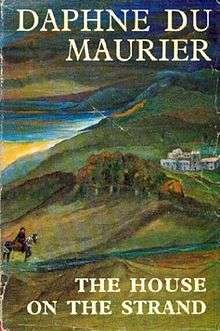The House on the Strand
 First edition | |
| Author | Daphne Du Maurier |
|---|---|
| Cover artist | Flavia Tower[1] |
| Country | United Kingdom |
| Language | English |
| Publisher | Victor Gollancz |
Publication date | 1969 |
| Media type | |
| Pages | 351 |
| ISBN | 0-575-00287-5 |
The House on the Strand is a novel by Daphne du Maurier. First published in 1969 by Victor Gollancz, it is one of her later works and had a jacket illustration by her daughter, Flavia Tower.[1][2] The US edition was published by Doubleday.
Like many of du Maurier's novels, The House on the Strand has a supernatural element (though in this case, it can also be accounted as science fiction). It is concerned with the ability to mentally travel back in time and experience historical events at first hand - but not to influence them.
It is set in and around Kilmarth (where Daphne du Maurier lived from 1967) near the Cornish village of Tywardreath, which in fact translates from the Cornish language as "House on the Strand".
Plot summary
The narrator, Richard "Dick" Young, has been offered the use of Kilmarth, a Cornwall estate owned by his biophysicist friend Magnus Lane. He reluctantly agrees to act as a test subject for a drug that Magnus has developed. On taking it for the first time, Dick finds that it enables him to enter into the landscape around him as it existed during the early 14th Century. He becomes drawn into the lives of the people he sees there and is soon addicted to the experience. Dick is compelled to follow Roger, steward to Sir Henry Champernoune and secret lover to his wife, Lady Isolda Carminowe. Dick comes to share this love.
Each visit corresponds to a key moment in the story of Isolda and Roger. Each time Dick returns to real time he is more confused; throughout the experience he is unable to interact with the couple. Any attempt to do so brings Dick crashing back to the present in a state of nauseous exhaustion. (The drug has other dangers in that following Roger means that Dick walks unaware through the modern landscape with all the danger that entails.)
Dick's wife, Vita, and his stepsons join him in Cornwall and are worried by his bizarre behaviour. It is made clear that Dick does not truly love his wife, and certainly does not want to act as father to her sons—which makes plausible his increasing desire to escape into the past. Magnus intends to join Dick, but is killed in what seems like a bizarre accident or suicide—struck by a train whilst straying onto the local railway track. Dick knows the truth, that Magnus was under the influence of the drug; this makes the inquest difficult.
Dick's penultimate trip ends with him attempting to attack a woman named Lady Joanna in the 14th Century, but in reality attacking Vita. She and her children hide from him and he contacts a doctor who helps to wean him from his addiction to the drug. Dick explains the power of the drug, and is informed by the doctor that analysis has revealed its extremely dangerous nature. However, Dick's addiction is such that he takes the last remaining dose soon after.
Dick's last visit culminates in Roger confessing his love and the fact that he ensured that Isolda died pleasantly rather than succumb to a worse fate. Roger dies and Dick wakes. Since both Roger (his doppelganger/receptor) and Isolda are dead, Dick has little incentive to return to the other world, but in any case there is no drug left to ease his passage there. As the book closes Dick attempts to pick up the phone but suddenly finds he is unable to grip it.
The ending is ambiguous: is Dick dead, paralysed or simply collapsing? Daphne du Maurier said of it: "What about the hero of The House on the Strand? What did it mean when he dropped the telephone at the end of the book? I don’t really know, but I rather think he was going to be paralysed for life. Don’t you?"
References
- 1 2 SF Encyclopedia Picture Gallery Retrieved 2013-08-04
- ↑ Who is Flavia Tower?